
 PSRD-Nakhlites.pdf
PSRD-Nakhlites.pdf
Meteorites from Mars have been in the news since last summer's announcement about possible fossils in a martian meteorite; see the October, 1996 Hot Idea of PSR Discoveries. But there is more to the study of martian meteorites than the search for life. These
igneous rocks contain detailed information about volcanism and other magmatic processes on the Red Planet. Mars had a very active igneous history, dotting the landscape with huge
volcanoes and covering extensive areas with sheets of lava. Images of the surface of Mars taken from orbit showed us these volcanic wonders from afar. The meteorites we have in hand provide us with more detailed information of what we glimpsed in the images.
One of the groups of meteorites thought to have come from Mars, the
nakhlites [nock-lites], has an unusual composition characterized by a high abundance of the mineral
pyroxene. Many experts have attributed the composition to accumulation of pyroxene in a thick
magma body beneath the surface. However, some features of the rock indicate more rapid crystallization, suggesting formation in a
lava flow. This has led to some confusing interpretations about the origin of these rocks. Were nakhlites formed underground or on the surface?
Geologists need to answer this question so we can know if we are studying the physics of martian lava flows on the surface or the physics of how magma moves inside a volcano.
What we need is information about the occurrence of the nakhlites on Mars. Collecting them directly from a martian lava flow would be ideal. But, until numerous robotic rovers and humans roam the surface of Mars, we will not have such important field information. Fortunately, a very similar rock type occurs in a few places on Earth. You are invited to come along on a field trip to eastern Ontario, Canada for a look at the rocks that we think are a match for the martian meteorites called nakhlites.
For my doctoral dissertation, I am working with G. Jeffrey Taylor at the University of Hawai'i to substantiate this Earth-Mars rock connection. Allan Treiman of the Lunar and Planetary Institute in Houston first alerted us to the similarity between an unusual lava flow in Canada and the nakhlites, and is working with us on the project. Ralph Harvey of Case Western Reserve University in Cleveland also helped us in our field investigations.
What Are Nakhlites?
Nakhlite meteorites are the "N" of the SNC martian meteorites, and are named for Nakhla [nock-la], a meteorite which fell in Egypt in 1911 [Data link from Meteoritical Database]. Reports say that the original meteorite broke into 40 pieces, one of which supposedly hit and killed a dog. The photograph below shows a slice of a nakhla stone 3 cm across.
Decades later, the other two nakhlite meteorites, Lafayette [Data link] and Governador Valadares [Data link], were linked to Nakhla by their similar ages (1.3 billion years old) and by their unusual composition. All three meteorites are made almost entirely of one mineral, pyroxene, a silicate containing calcium, iron, and magnesium. Despite their history of being blasted off Mars by an
impact, the three nakhlites show no mineralogic effects from the cratering event that launched them.
Did Nakhlites Form in Sills or Lava Flows?
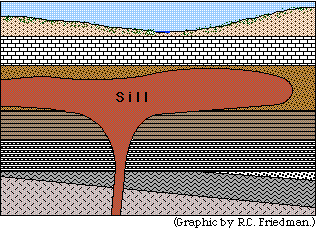 |
|
A sill forms when a magma intrudes between layers of rock underground. The magma never makes it to the surface. Instead, it cools slowly in place, thermally insulated by the rocks above and below. |
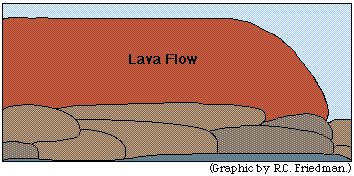 |
|
In contrast, a lava flow forms when magma erupts at the surface and flows along the ground. Lava flows can vary in thickness, from centimeters to tens of meters. The thinner the flow, the faster it cools.
Most investigators think that the large proportion of pyroxene in the nakhlites is best explained by formation in an intrusive body like a sill, where the slow cooling gives the pyroxene crystals time to sink and accumulate to high concentrations (70-80% of the rock). But the nakhlites have other features, like fine-grained areas between the pyroxene crystals and high concentration of calcium in the mineral
olivine, which usually suggest formation in a rapidly cooled body, like a lava flow. The idea of nakhlites forming in a lava flow can be tested by examining a similar lava flow on Earth and comparing it to the nakhlites.
|
Theo's flow, Ontario: A Mars-like Rock on Earth
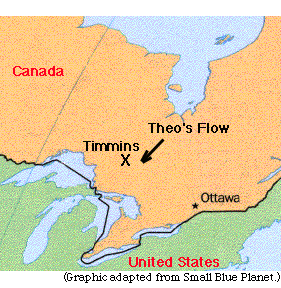 |
|
Theo's flow in Ontario, Canada is 2.6 billion years old. It is unusually thick for a lava flow (120 meters thick!), and is geographically associated with several thick
intrusive sills, but a study by Nick Arndt in the late 1970's identified Theo's flow as an erupted lava flow. The best evidence that Arndt found for an
extrusive origin is the knobby top layer of the flow. |
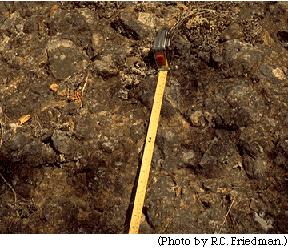 |
The top of Theo's flow is brecciated (or broken up) like the clinkery top of an
'a'a lava flow. Intrusive sills don't have brecciated tops; instead, they have a glassy or finely crystallized margin at their top boundary where they cooled rapidly against the overlying rock. Arndt described this layer thoroughly, likening it to the rubbley material produced by the interaction of hot magma with water in a submarine eruption. |
Another unusual aspect of Theo's flow is that while it is one flow unit, there are several rock types that make it up: a
peridotite (rich in olivine) at the bottom, a thick middle layer of
pyroxenite, and an upper layer of
gabbro (pyroxene + feldspar). The middle layer is what interests us as an analog for the martian nakhlites. Despite coming from different planets and having formed a billion years apart, when seen through a microscope, Nakhla and Theo's pyroxenite look amazingly similar.
 |
Photograph taken with a microscope at 25x magnification of a Nakhla meteorite
thin section(field of view is about 5 millimeters across).
|
 |
Photograph taken with a microscope at 25x magnification of a thin section of a Theo's flow sample (field of view is about 5 millimeters across). |
Both rocks are primarily composed of calcium-rich pyroxene and the material between pyroxene crystals is rich in feldspar. They have similar average grain sizes and compositions and record similar cooling times. This has led us to suggest the Nakhlites formed in a thick lava flow like Theo's. By studying Theo's flow in detail, then, we may shed light on the formation of nakhlites.
To follow up Arndt's work, we sampled Theo's flow at certain intervals to take a closer look at the whole of the flow. We took samples to measure mineral abundances and compositions, crystal sizes, and whole rock compositions. The next two photographs illustrate the conditions in the field.
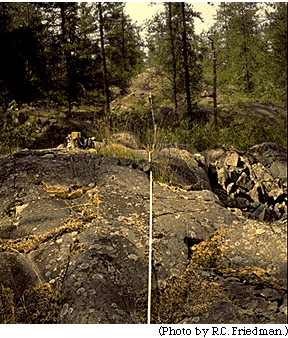 |
The ancient rock of Theo's flow was tilted 90o so that a walk along the ground today lets us see the flow from bottom to top. This tape-measure extends from the base to the top of Theo's flow. It enabled us to note where we took our rock samples in relation to the height of the flow. |
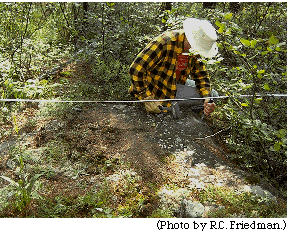 |
Jeff Taylor (my advisor, University of Hawaii) makes himself useful. He is using a rock hammer and chisel to help collect rock samples to be analyzed back in the lab in Hawai'i. |
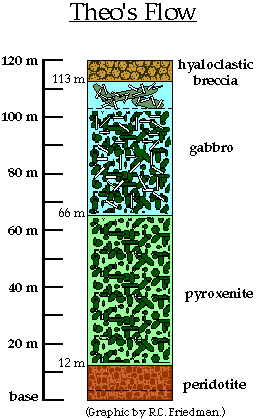 |
On the left is a pictorial representation, called a
stratigraphic column, of the different rock types that make up Theo's flow. The samples we took along our traverse line gave us all the pertinent information about the different rock layers to help us put together a cooling history for the flow.
A detailed study of the different layers shows that Theo's flow did start as one magma body and then separated into discrete layers. As the flow cooled in place, crystals grew and settled through the liquid lava, changing the composition of the melt with the growth of each new crystal and thereby changing the composition of each subsequent crystal grown from the evolved melt. Thus, the different layers in Theo's flow are intimately related to each other. If the nakhlites did form in a similar setting, we would expect other nakhlite-like flows to be associated with peridotites and gabbros. |
 |
Hawaiian pahoehoe lava. |
Aside from shedding light on how nakhlites may have formed, this study of Theo's flow will help us to better understand the processes that occur in lava flows on Earth. Regardless of the magma type, crystal formation, growth and settling are important processes that govern the character of the solidified lava flow.

1996
psrd@higp.hawaii.edu
main URL is http://www.psrd.hawaii.edu/

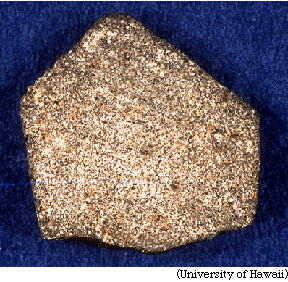










![]()